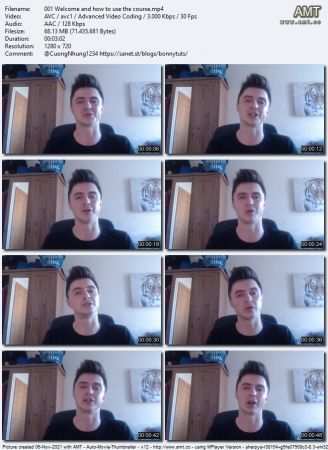|
Computational Fluid Dynamics Fundamentals Course 2

https://TutGee.com
MP4 | Video: h264, 1280x720 | Audio: AAC, 44.1 KHz, 2 Ch
Genre: eLearning | Language: English + srt | Duration: 9 lectures (2h 30m) | Size: 1.55 GB
Wall Functions, 2D Simulations and Boundary Conditions
What you'll learn:
How to setup and structure a working CFD solution code from first principles (using Excel, MATLAB or Python)
How Dirichlet and Neumann Boundary Conditions are translated into CFD matrix equations
How to set up and solve 2D CFD solutions from first principles
How Wall Functions are actually employed by CFD codes
The utility of heat flux balances that can be generated from CFD solutions
Requirements
Basic vector calculus (dot product, gradient, cross product)
Basic differential equations
Basic linear algebra (matrices)
Microsoft Excel, Python or MATLAB
Description
Welcome to Part 2 of my Computational Fluid Dynamics (CFD) fundamentals course! In this course, the concepts, derivations and examples from Part 1 are extended to look at 2D simulations, wall functions (U+, y+ and y*) and Dirichlet and Neumann boundary conditions. The course starts from first principles and you will rapidly develop working CFD solutions using the Excel sheets, MATLAB code and Python source code provided (you can complete the course with either Excel, MATLAB or python). By the end of the course, you will understand the importance of heat flux balances, residuals and wall functions (y+, U+ and y*). This course also presents a unique working example for temperature wall functions (never seen before on the internet), to show you exactly how wall functions are employed by CFD solvers. No prior experience is required and no specific CFD code/coding experience is required! You do not need ANSYS Fluent, OpenFOAM, Star CCM or any other CFD to use this course.
This course does not teach you how to use specific functionality in different CFD packages. Instead it provides fundamental understanding that you can use to understand how all CFD codes work behind the scenes and actually see the matrices as they are assembled and solved. You can use this understanding throughout your career in CFD to move between different CFD codes and understand the fundamental features that make them all work. This information is essential for any world-class CFD engineer. |
|
udp://tracker.torrent.eu.org:451/announce udp://tracker.tiny-vps.com:6969/announce http://tracker.foreverpirates.co:80/announce udp://tracker.cyberia.is:6969/announce udp://exodus.desync.com:6969/announce udp://explodie.org:6969/announce udp://tracker.opentrackr.org:1337/announce udp://9.rarbg.to:2780/announce udp://tracker.internetwarriors.net:1337/announce udp://ipv4.tracker.harry.lu:80/announce udp://open.stealth.si:80/announce udp://9.rarbg.to:2900/announce udp://9.rarbg.me:2720/announce udp://opentor.org:2710/announce |

